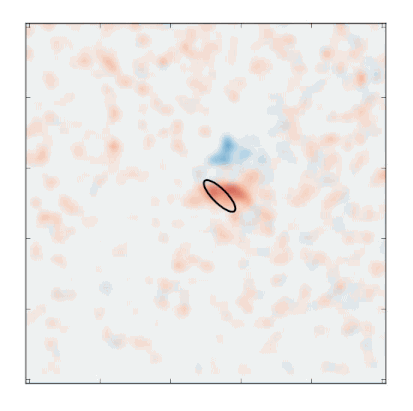X-ray Microscope Reveals 'Solitons,' a Special Type of Magnetic Wave
Scientists Hope to Control its Properties to Create a New Form of Electronics
Researchers used a powerful, custom-built X-ray microscope at the Department of Energy's SLAC National Accelerator Laboratory to directly observe the magnetic version of a soliton, a type of wave that can travel without resistance. Scientists are exploring whether such magnetic waves can be used to carry and store information in a new, more efficient form of computer memory that requires less energy and generates less heat.
Magnetic solitons are remarkably stable and hold their shape and strength as they travel across a magnetic material, just as tsunamis maintain their strength and form while traversing the ocean. This offers an advantage over materials used in modern electronics, which require more energy to move data due to resistance, which causes them to heat up.
In experiments at SLAC’s Stanford Synchrotron Radiation Lightsource, a DOE Office of Science User Facility, researchers captured the first X-ray images of solitons and a mini-movie of solitons that were generated by hitting a magnetic material with electric current to excite rippling magnetic effects. Results from two independent experiments were published Nov. 16 in Nature Communications and Sept. 17 in Physical Review Letters.
“Magnetism has been used for navigation for thousands of years and more recently to build generators, motors and data storage devices,” said co-author Hendrik Ohldag, a scientist at SSRL. “However, magnetic elements were mostly viewed as static and uniform. To push the limits of energy efficiency in the future we need to understand better how magnetic devices behave on fast timescales at the nanoscale, which is why we are using this dedicated ultrafast X-ray microscope.”
“This is an exciting observation because it shows that small magnetic waves – known as spin-waves – can add up to a large one in a magnet,” explains Andrew Kent, a professor of physics at New York University and a senior author for one of the studies.. “A specialized X-ray method that can focus on particular magnetic elements with very high resolution enabled this discovery and should enable many more insights into this behavior.”
Solitons are a form of spin waves, which are disturbances that propagate in a magnetic material as a patterned, rippling response in the material’s electrons. This response is related to the spin of electrons, a fundamental particle property that can be thought of as either “up” or “down” – like the head or tail sides of a coin.

In 1834 John Scott Russell, a Scottish civil engineer and shipbuilder, first described his observation of the soliton phenomenon in a boat-produced wave that held a uniform shape for over a mile as it traveled down a canal. Solitons had for decades been theorized to occur in magnets, but it took a specialized X-ray microscope like the one at SLAC to directly observe the effect.
"We built a microscope that allowed us to look at these magnetic waves in a new way," said Stefano Bonetti, the leading author of the study published in Nature Communications. Bonetti is a Stanford University postdoctoral fellow now at Stockholm University. "With this new microscope, we can actually see them moving,” he said. “We can see things directly."
An ultrafast camera coupled to the microscope allowed researchers to record six images that were compiled in sequence to form a “movie” of the soliton’s motion. It took about 12 hours to record enough X-ray data to produce the movie.
The high resolution of the X-ray microscope revealed an anomaly in the spin-wave effects: While researchers expected the soliton to fully flip the local magnetic alignment of the material, like a compass switching from north to south, they found that the soliton caused the material’s magnetic orientation to change only slightly.
"We would expect to see this reverse, or flip," Bonetti said. "But it didn't reverse – it just tilted about 25 degrees. The situation is not as simple as people thought."
Also, in one of the experiments researchers saw the soliton split in two: it was expected to take a spherical or circular form, but instead appeared split down the middle, as if an approaching ocean wave had split into two separate waves that were mirror images of each other. “In the simulations we were using before, we were blind to this possibility,” Bonetti said.
More experiments are needed to understand both the tilting effect and the way that the soliton can split into a mirrored form, Bonetti said. Simulations could help researchers learn how to convert the mirrored pattern of the soliton into a more uniformly symmetrical shape, he said, or to understand how to use the split form for data applications.
Researchers from Stanford University; SIMES, the Stanford Institute for Materials and Energy Sciences at SLAC; University of Barcelona in Spain; KTH Royal Institute of Technology in Sweden; New York University; HGST, a Western Digital Company; and Emory University in Georgia also contributed to the study. The work was supported by Everspin Technologies, the DOE Office of Science, the Knut and Alice Wallenberg Foundation, the Swedish Research Council, the Catalan Government, the National Science Foundation, the Forsk Foundation, the European Commission, the U.S. Army Research Office and Brookhaven National Laboratory.
View a related press release by New York University.
Citations: S. Bonetti, et al., Nature Communications, 16 November 2015 (10.1038/NCOMMS9889)
D. Backes, et al., Physical Review Letters, 17 September 2015 (10.1103/PhysRevLett.115.127205)
Contact
For questions or comments, contact the SLAC Office of Communications at communications@slac.stanford.edu.
SLAC is a multi-program laboratory exploring frontier questions in photon science, astrophysics, particle physics and accelerator research. Located in Menlo Park, Calif., SLAC is operated by Stanford University for the U.S. Department of Energy's Office of Science.
SLAC National Accelerator Laboratory is supported by the Office of Science of the U.S. Department of Energy. The Office of Science is the single largest supporter of basic research in the physical sciences in the United States, and is working to address some of the most pressing challenges of our time. For more information, please visit science.energy.gov.






